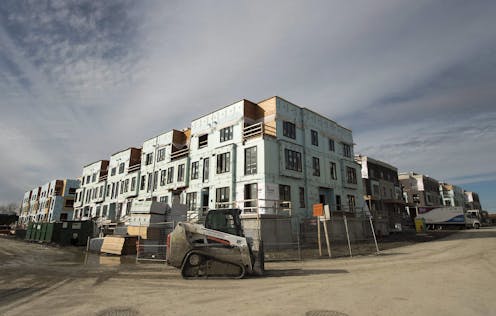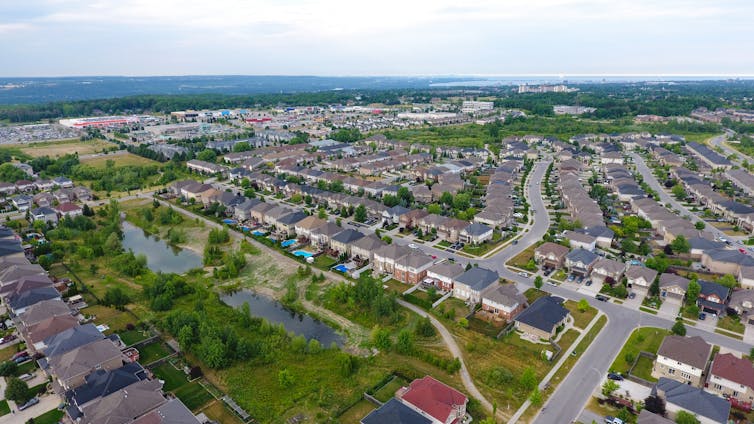
The Ontario government recently proposed a new bill, the More Homes Built Faster Act, or Bill 23. This bill contains some positive elements, like the removal of duplicate plan approval requirements and adding measures aimed at increasing urban density and housing mix.
However, Bill 23 also proposes weakening or eliminating many housing development regulations, such as site plan controls, that protect us and our natural environment from the negative effects of poorly built development. If implemented as tabled, the bill will severely disrupt the province’s environmental housing regulations.
The housing sector is one of the largest contributors to Ontario’s greenhouse gas emissions. It contributes 23 per cent of total greenhouse gas emissions of the province, second only to transportation.
Poorly regulated housing can lead to more greenhouse gas emissions through energy loss, increased energy requirements and greater exposure to weather extremes. This would contribute to accelerating climate change, exposing many Ontario residents to the accompanying risks to human health, well-being and property.
Climate change and housing
A recent poll showed that 74 per cent of Ontario residents are worried about climate change. Sixty-eight per cent of the province’s population agree that climate change is caused by human activities; over half said that they personally have experienced the consequences of climate change. Therefore, climate change should be central to the policies that shape our province’s future.
Recent research has demonstrated that substantial amounts of urban green spaces and trees — more than 40 per cent tree canopy cover — may be required to help us protect urban communities against excess heat. However, most Canadian cities, including those in Ontario, continue to lose green spaces and trees.
Research also shows that our most disadvantaged and vulnerable populations are disproportionately exposed to climate change risks. Green spaces in Canadian cities are not evenly distributed.

Wealthier neighbourhoods and those with fewer immigrants enjoy more green spaces and the benefits they provide in comparison to poorer neighbourhoods and those with more immigrants.
In Toronto, recent research confirms that the poorest neighbourhoods are the most vulnerable to flooding due to a lack of vital natural infrastructure such as bodies of water and green spaces. These environmental injustices should be a main concern addressed by new policy.
In addition, recent research reveals that high air temperatures are connected to increased risk of hospital admissions. By 2050, summer temperatures increased by climate change are expected to lead to significant growth in the demand for in-patient hospital care.
Worsening climate risks
Unfortunately, Bill 23, as currently conceived, may make all of this worse. It removes all municipal controls over exterior design of residential developments.
First, this may lead to poorly regulated housing and compromised visual quality and appeal that would inevitably detract from, instead of increase, property value. Over time, this would put the financial investment of owners in their property at risk.
Second, removing all sustainable site plan controls may encourage the increase of impervious surfaces that significantly amplify the risk of urban floods from rainwater runoff. This is exacerbated by Bill 23’s reduction of parkland dedication requirements by half, which is likely to cause a loss of the green spaces and bodies of water that we need to cope with climate-related risks like heat and flooding.
Worse still, by curbing the authority of conservation authorities, Bill 23 may endanger people’s lives and property when their houses are built in areas exposed to risks from flooding and pollution. Bill 23’s environmental peril is compounded with the proposed changes that will open up the Greenbelt for development.
While the housing crisis clearly needs to be addressed, Bill 23 proposes to solve one crisis (housing) at the expense of another (climate change). Despite the bill’s positive components, the removal of many environmental regulations will saddle future homeowners with the costs of having to upgrade and repair their houses when their properties get flooded or when it turns out that their land doesn’t have trees and other plants that help protect against increasing urban heat.
These are not just concerns of a few environmental groups that can be easily ignored in the political calculus. In the future, all Ontario residents may have to pay the price for some of the worrying policy choices that are included in Bill 23.
For Ontario municipalities and conservation authorities to continue their work to protect, expand and maintain urban green spaces, forests and bodies of water, Bill 23 must be amended.
There are land developers who make great efforts to build residential developments that are meeting or exceeding sustainability standards, regardless of whether they’re required by environmental regulations. These progressive businesses deserve our support. However, a wholesale removal or weakening of environmental regulations opens the door for an increase in housing developments that do not meet these standards.
We cannot afford to lose our urban green spaces and bodies of water. These natural spaces are not a luxury, but are vital infrastructure needed to help protect our communities against the worst effects of climate change.
Michael Drescher receives funding from the Social Sciences and Humanities Research Council of Canada, Environment and Climate Change Canada, and the Municipal Natural Assets Initiative.
Luna Khirfan receives funding from the Social Sciences and Humanities Research Council (SSHRC) of Canada. She is also an elected Governing Board Member of the Association of Collegiate Schools of Planning (ACSP).
This article was originally published on The Conversation. Read the original article.







